
Passiflora, known also as the passion flowers or passion vines, is a genus of about 550 species of flowering plants, the type genus of the family Passifloraceae.
In biology, a monotypic taxon is a taxonomic group (taxon) that contains only one immediately subordinate taxon. A monotypic species is one that does not include subspecies or smaller, infraspecific taxa. In the case of genera, the term "unispecific" or "monospecific" is sometimes preferred. In botanical nomenclature, a monotypic genus is a genus in the special case where a genus and a single species are simultaneously described. In contrast, an oligotypic taxon contains more than one but only a very few subordinate taxa.

Asclepias is a genus of herbaceous, perennial, flowering plants known as milkweeds, named for their latex, a milky substance containing cardiac glycosides termed cardenolides, exuded where cells are damaged. Most species are toxic to humans and many other species, primarily due to the presence of cardenolides. However, as with many such plants, some species feed upon milkweed leaves or the nectar from their flowers. A noteworthy feeder on milkweeds is the monarch butterfly, which uses and requires certain milkweeds as host plants for their larvae.

The southern giant hummingbird is one of two species in the genus Patagona and the second largest hummingbird species, after its close relative the northern giant hummingbird.
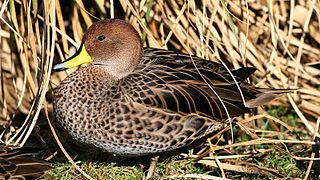
The yellow-billed pintail is a South American dabbling duck of the genus Anas with three described subspecies.
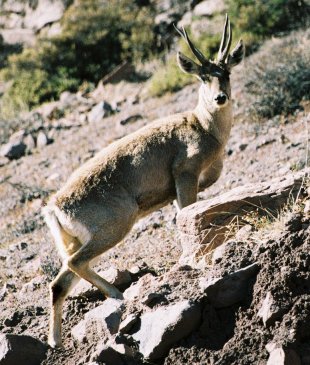
Hippocamelus is a genus of Cervidae, the deer family. It comprises two extant Andean and two fossil species. The living members are commonly known as the huemul, and the taruca, also known as northern huemul.

Pyrgus is a genus in the skippers butterfly family, Hesperiidae, known as the grizzled skippers. The name "checkered" or "chequered skipper" may also be applied to some species, but also refers to species in the genera Burnsius and Carterocephalus. They occur in the Holarctic with an additional group of species extending to the Neotropic.

Oberthür's grizzled skipper is a species of skipper.

Laguna Lejía is a salt lake located in the Altiplano of the Antofagasta Region of northern Chile. The landscape of the area is dominated by the volcanoes Chiliques, Lascar, Aguas Calientes and Acamarachi. It is shallow and has no outlet, covering a surface area of about 1.9 square kilometres (0.73 sq mi) in the present-day.

The Pyrgini are a tribe in the skipper butterfly subfamily Pyrginae. Formerly, when only four tribes of Pyrginae were recognized, the Pyrgini contained the largest number of genera among these. But this overly wide delimitation has since turned out to be paraphyletic.

Urbanus is a genus of skipper butterflies erected by Jacob Hübner in 1807, placed to subtribe Eudamina. Species of the genus are found from the southern United States to South America.

Spialia sertorius, commonly known as the red-underwing skipper, is a butterfly of the family Hesperiidae.

The safflower skipper is a species of skipper butterfly.
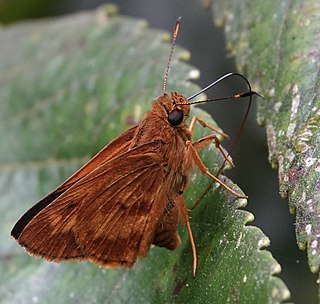
Racta is a genus of grass skippers in the butterfly family Hesperiidae.

Burnsius albezens, the white checkered-skipper, formerly known as Burnsius albescens and Pyrgus albescens, is a species of skipper. It is found at low altitudes in the southern United States and Mexico. It is a rare stray to southwest Utah and central Texas and is found in a variety of dry, open habitats.

Burnsius oileus, the tropical checkered skipper, is a species of skipper. It is found in the United States, south through the West Indies, Mexico and Central America to Costa Rica. It was transferred to genus Burnsius in 2019, and was previously known as Pyrgus oileus.

Burnsius is a genus of New World checkered-skippers in the butterfly family Hesperiidae. The genus was erected by Nick V. Grishin in 2019.
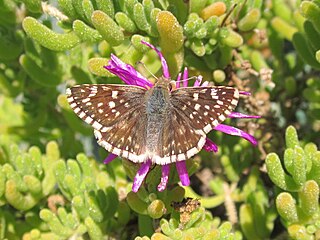
Chirgus is a genus of checkered-skippers, white-skippers, and allies in the butterfly family Hesperiidae, found in the New World. The genus was erected by Nick V. Grishin in 2019. There are about six described species in Chirgus.
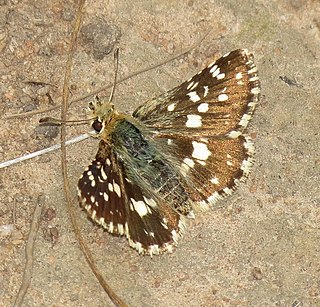
Agyllia is a genus of spread-wing skippers in the butterfly family Hesperiidae, erected in 2020. There are at least three described species in Agyllia, all found in Africa. These species were formerly members of the genus Spialia.

















